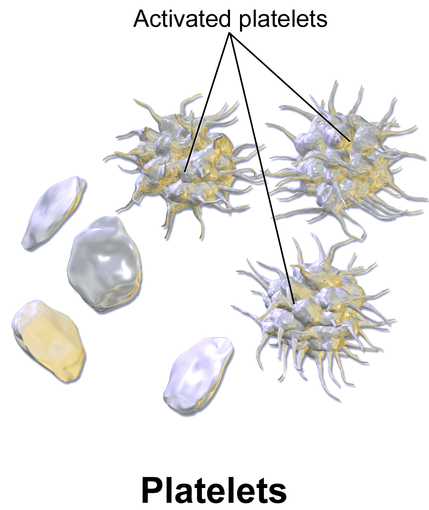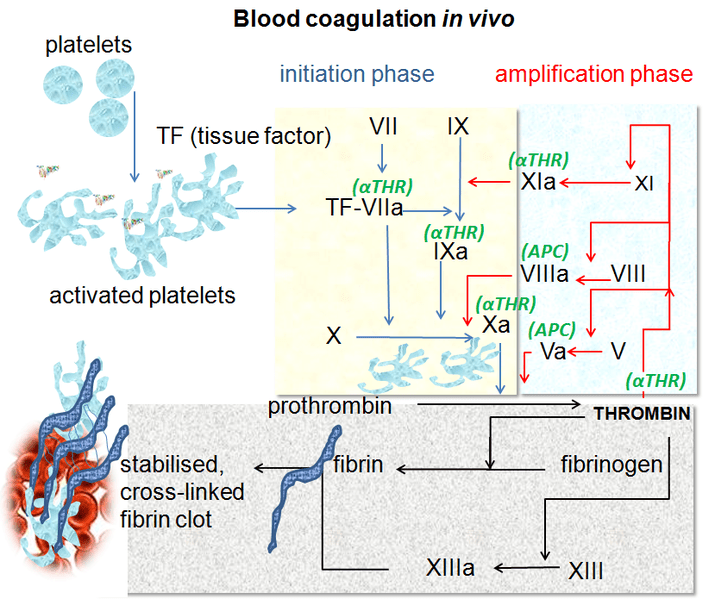Difference Between Platelets and Clotting Factors
Key Difference – Platelets vs Clotting Factors
Blood coagulation is an important process. When a blood vessel is injured or cut, it should be prevented from the excessive loss of blood from the blood system before leading to a shock or death. It is done by converting the specific circulating elements in the blood system into an insoluble gel-like substance at the injured site. This is known as blood clotting or blood coagulation. Due to this process, continuous blood loss from injured blood vessels, tissues and organs, is stopped, and as a result, possible complications are prevented as soon as possible. Blood coagulation is accomplished by making a blood clot. A blood clot consists of a plug of platelets and a network of insoluble fibrin molecules. Blood coagulation is mainly done by the formation of a fibrin clot. Fibrin is an insoluble, fibrous and non-globular protein that involves the clotting of blood. It is the underlying fabric polymer of a blood clot. Fibrin formation occurs in response to an injury in any part of the vascular system or the circulatory system. When there is an injury, protease enzyme called thrombin acts on fibrinogen and causes it to polymerize into fibrin, which is an insoluble gel-like protein. Then fibrin together with platelets creates a blood clot on the wound site to prevent continues bleeding. Platelets are a type of blood cell, required in the clotting process. Clotting factors are substances in the blood that act sequentially to form and strengthen the blood clot to stop bleeding. This is the key difference between platelets and clotting factors.
CONTENTS
1. Overview and Key Difference
2. What are Platelets
3. What are Clotting Factors
4. Similarities Between Platelets and Clotting Factors
5. Side by Side Comparison – Platelets vs Clotting Factors in Tabular Form
6. Summary
What are Platelets?
Platelets are small disk-shaped cells found in large numbers of the blood. Platelets are also known as thrombocytes. They don’t have a nucleus. Platelets account for nearly 20% of the total blood cell count. The diameter of the platelet lies between 3 to 4 μm. A healthy person has a platelet count between 150,000 to 450,000 per µl of blood. By a complete blood count, platelet count can be estimated in the blood. The lifetime of a platelet ranges 8 to 10 days. Platelets are produced by the bone marrows of our body. The main function of platelets is to facilitate the process of blood clotting by forming a platelet plug in the first phase of the blood clotting process.
Platelets also produce the platelet factor 3 that is important in the reaction process of coagulation. When the normal vascular integrity is disrupted due to an injury, circulating platelets and other factors assemble near the site of injury. Prostaglandins such as thromboxane aid the process of platelet aggregation and this are followed by the formation of the fibrin network on the site of injury to prevent further blood loss.
Disorders of platelets can cause many imbalances in the body. Certain health medications such as aspirin (a non-steroidal anti-inflammatory drug) are administered to prevent blood clotting by interrupting a specific step of platelet aggregation.

Figure 01: Platelets
Abnormal levels of platelets in the blood cause few conditions in the body. Thrombocytopenia is a condition that is characterized by abnormally low levels of platelets in the blood. Thrombocytopenia can also be a result of certain viral infections such as Dengue, where the virus is capable of destructing platelets causing the platelet levels to decrease rapidly.
What are Clotting Factors?
Clotting factors are the substances in the blood that are sequentially working to form a blood clot and stop bleeding. They are also known as coagulation factors. There are different types of clotting factors such as soluble plasma factors. Among them, some are plasma proteins while some inorganic ions are also found.

Figure 02: Coagulation Process
Some of the significant clotting factors are listed below with their roles during the blood clot formation.
What are the Similarities Between Platelets and Clotting Factors?
- Platelets and clotting factors are found in the blood.
- Both Platelets and Clotting Factors are components involved in blood coagulation.
- Both Platelets and Clotting Factors have utmost importance in stop bleeding.
What is the Difference Between Platelets and Clotting Factors?
Platelets vs Clotting Factors | |
| Platelets are tiny disk-shaped blood cells that are important to form blood clots to stop bleeding. | Clotting Factors are the substances of the blood that involve in blood coagulation process. |
| Type | |
| Platelets are anucleated tiny disk-like cells. | Clotting factors are plasma proteins, inorganic ions or plasma membrane glycoproteins. |
Summary – Platelets vs Clotting Factors
Blood clotting is an important natural process that occurs soon after a blood vessel is injured. It prevents excessive bleeding and blood loss that can be fatal. Several components of the blood are involved in blood coagulation. Among them, platelets and coagulation factors or the clotting factors are important two components. Platelets are tiny disk-shaped cells of the blood that forms the platelet plug to block the injured site and prevent bleeding. Clotting factors are the substances of the blood that sequentially act and form a stable and strong fibrin blood clot at the injured site. This is the difference between platelets and clotting factors.
Reference:
1.“What Are Platelets?” What Are Platelets? – Health Encyclopedia – University of Rochester Medical Center. Available here
2.“Coagulation.” Wikipedia, Wikimedia Foundation, 28 Feb. 2018. Available here
Image Courtesy:
1.’Blausen 0740 Platelets’By Blausen.com staff (2014). “Medical gallery of Blausen Medical 2014”. WikiJournal of Medicine 1 (2). DOI:10.15347/wjm/2014.010. ISSN 2002-4436. – Own work, (CC BY 3.0) via Commons Wikimedia
2.’Coagulation in vivo’By Dr Graham Beards – Own work, (CC BY-SA 3.0) via Commons Wikimedia
ncG1vNJzZmivp6x7pbXFn5yrnZ6YsqOx07CcnqZemLyue8OinZ%2Bdopq7pLGMm5ytr5Wau268y5qrnqSVqcBurc2dZK%2BrXZi5sMDToqWgZZaWsLW70axm